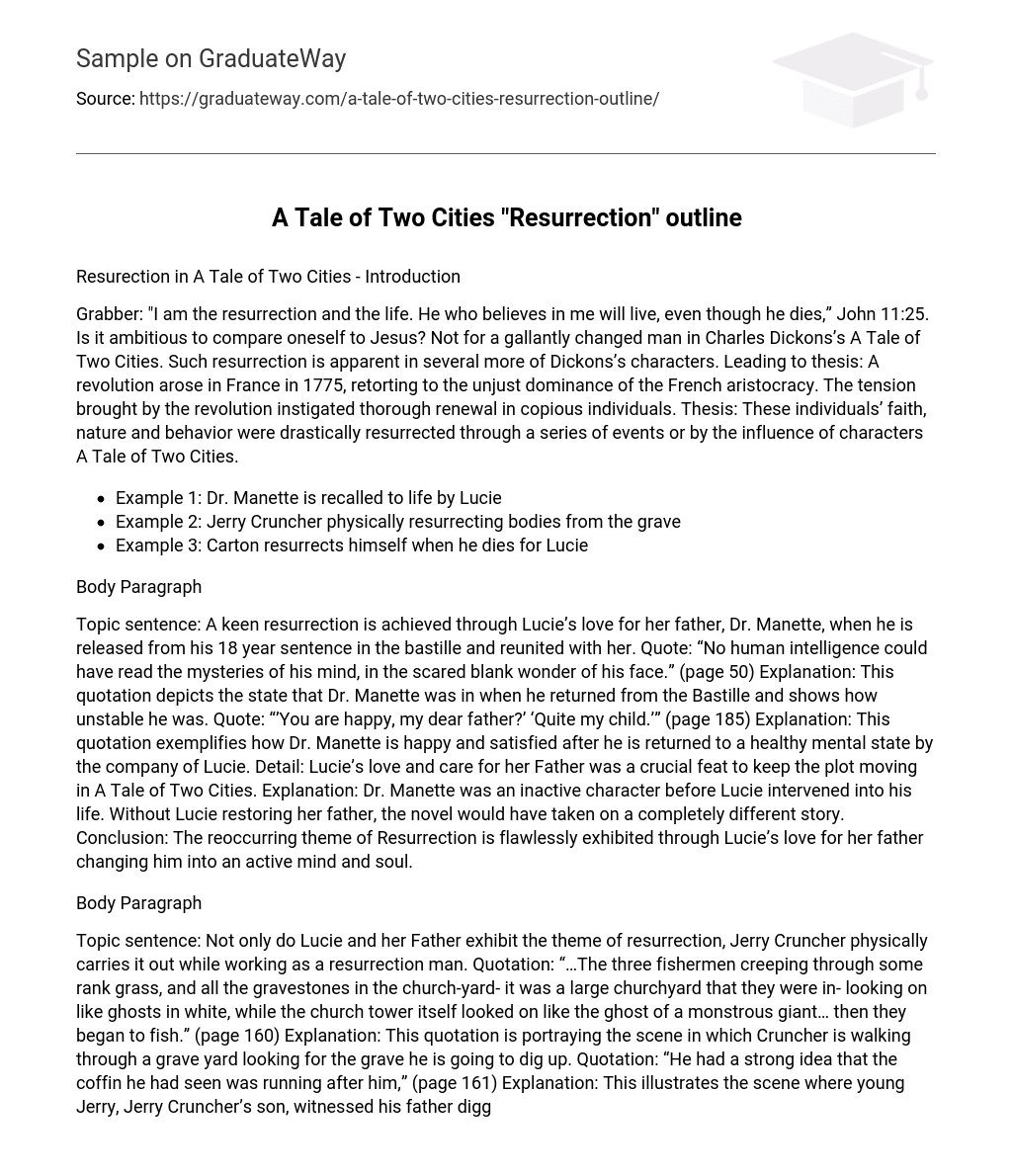Resurection in A Tale of Two Cities – Introduction
Grabber: “I am the resurrection and the life. He who believes in me will live, even though he dies,” John 11:25. Comparing oneself to Jesus may seem ambitious, but it is not the case for a gallantly changed man in Charles Dickons’s A Tale of Two Cities. This resurrection can also be seen in other characters created by Dickons. This leads to the thesis that a revolution occurred in France in 1775, in response to the unjust dominance of the French aristocracy. The tension caused by this revolution sparked a significant transformation in many individuals. These individuals’ faith, nature, and behavior were dramatically revived either through a series of events or by the influence of characters in A Tale of Two Cities.
- Example 1: Dr. Manette is recalled to life by Lucie
- Example 2: Jerry Cruncher physically resurrecting bodies from the grave
- Example 3: Carton resurrects himself when he dies for Lucie
Body Paragraph
Topic sentence: Lucie’s love for her father, Dr. Manette, achieves a remarkable resurrection as he is released from his 18-year sentence in the Bastille and reunited with her. Quote: “No human intelligence could have read the mysteries of his mind, in the scared blank wonder of his face.” (page 50) Explanation: This quote illustrates the state of instability in which Dr. Manette was when he returned from the Bastille. Quote: “’You are happy, my dear father?’ ‘Quite my child.’” (page 185) Explanation: This quote showcases Dr. Manette’s contentment and satisfaction after being restored to a healthy mental state by Lucie’s presence. Detail: Lucie’s love and care for her father played a crucial role in propelling the plot forward in A Tale of Two Cities. Explanation: Dr. Manette was a passive character until Lucie intervened in his life. Without Lucie’s intervention, the novel would have taken a completely different direction. Conclusion: Lucie’s love for her father flawlessly exemplifies the recurring theme of resurrection by transforming him into an active and awakened individual.
Body Paragraph
The theme of resurrection is exhibited by Lucie and her Father, as well as physically carried out by Jerry Cruncher, who works as a resurrection man. The scene is described as three fishermen creeping through grass, with gravestones in the churchyard resembling white ghosts, while the church tower itself appears like the ghost of a monstrous giant. Cruncher is in search of a specific grave to dig up. Young Jerry, Cruncher’s son, witnesses his father digging up a man’s grave and has a strong impression that the coffin he saw was chasing after him. In contrast to other examples of resurrection, where the mind or spirit is revived, Cruncher brings bodies back to life from the grave.
Topic sentence: Charles Dickens explores various forms of resurrection, including physical, spiritual, and personal, through the character of Sydney Carton.
Quotation: “I am thankful that the time has come, when I can prove them. That I do so is no subject for regret or grief.” (page 349)
Explanation: Through this quote, Carton expresses his acceptance and lack of remorse for sacrificing his own life for Lucie’s sake.
Quotation: “It is a far, far better thing that I do, than I have ever done: it is a far, far better rest that I go to than I have ever known.” (page 372)
Explanation: Here, Carton declares that giving up his own fortune brings him a sense of fulfillment and surpasses any previous accomplishments.
Detail: By shedding his identity as the Jackal and finding happiness in sacrificing himself for Lucie’s wellbeing, Carton experiences a personal resurrection.
Conclusion: In summary, Carton serves as a prominent embodiment of the theme of resurrection in the novel by being content with his own sacrifice for the betterment of Lucie’s life.
Conclusion
Summary statement: The theme of resurrection is revisited throughout A Tale of Two Cities. Lucie’s love for her father brought him back from his ill mental state. Jerry Cruncher also resurrected bodies as a resurrection man. Additionally, Carton realized that his life would only have meaning if he sacrificed himself for Lucie’s well-being. Broader significance: Charles Dickens’ work relies on the concept of resurrection to drive the plot. Similarly, in our own lives, resurrection plays a vital role in restoring and reviving us when we need it the most.





